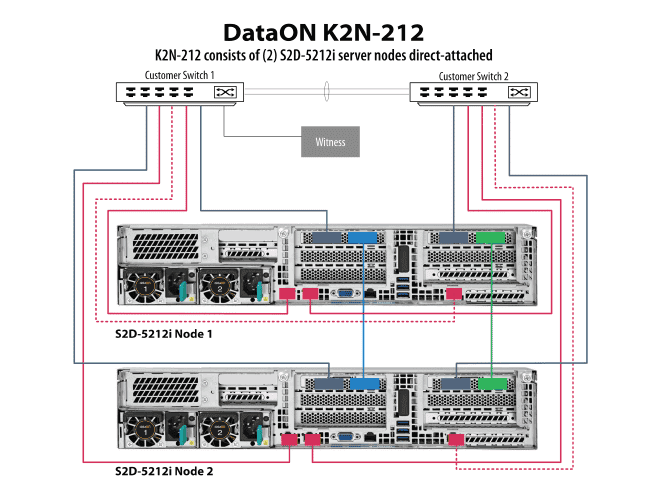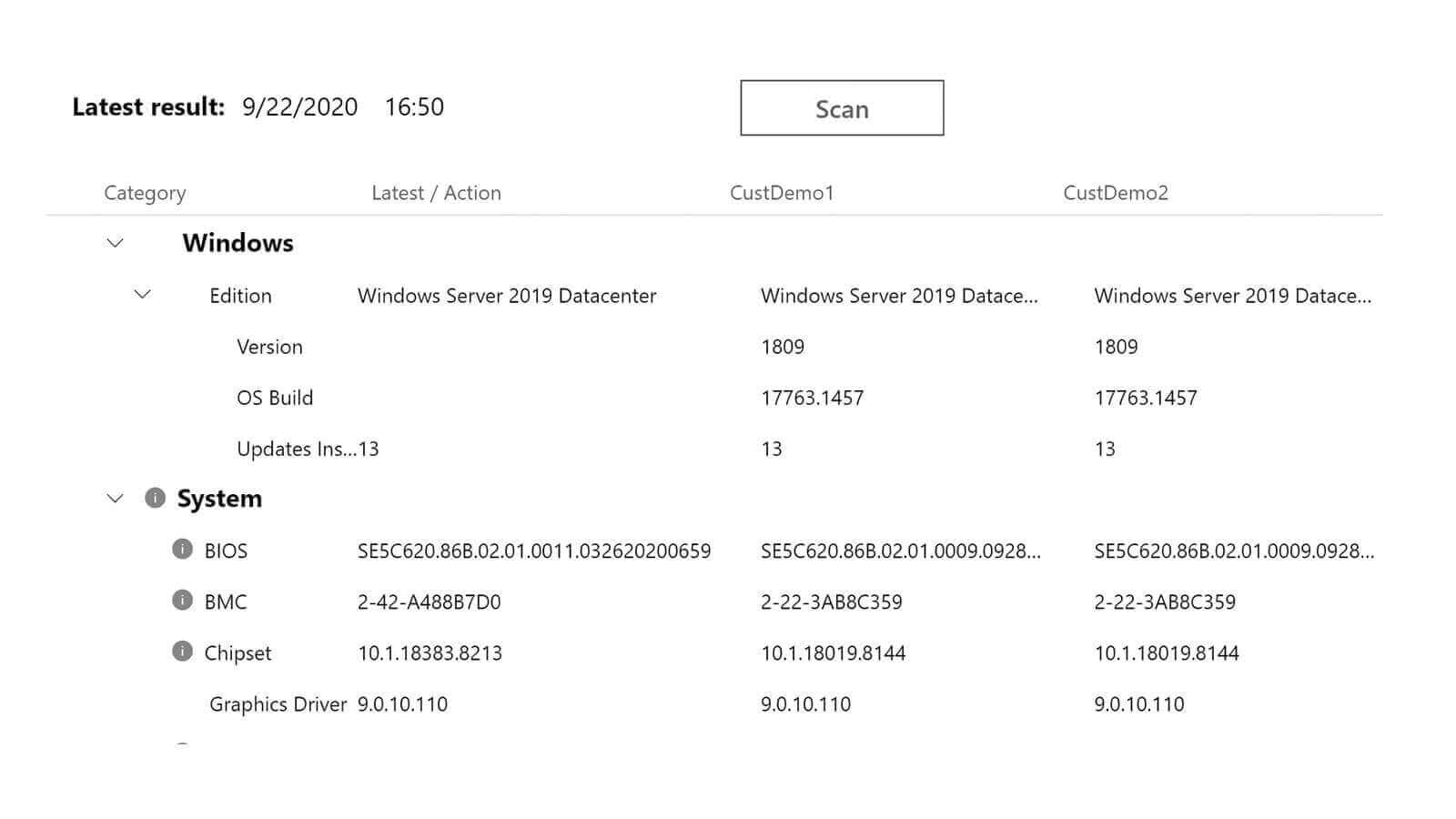
Solutions
- DataON K2N-224 with Intel® NVMe flash storage
- DataON HCI-212 with Intel® NVMe flash storage and Western Digital Ultrastar® HDDs
- DataON K2N-212 with Intel® NVMe flash and Western Digital Ultrastar® HDDs
- Azure Stack HCI
- SQL Server
- DataON MUST monitoring and management software tool for Windows Admin Center
- NVIDIA Mellanox ConnectX-4
- Veeam Backup and Replication
Industry
- Insurance
Org Size
- 1 to 50 employees
Country
- United States
Download
The Challenge
- Refresh Microsoft Storage Spaces converged infrastructure with cost-efficient hyper-converged solution
- Boost IOPS, SQL Server, and backup performance
- Increase storage capacity
- Improve infrastructure visibility
- Acquire a dependable solution with world-class customer support and warranty
The Solution
- Azure Stack HCI
- SQL Server and High-Performance Applications – DataON K2N-224 with all Intel® P4510 all-NVMe flash
- General Applications – DataON HCI-212 with Intel® P4610 NVMe flash and Western Digital Ultrastar HDDs
- Backup and DR – DataON K2N-212 with Intel® P4610 NVMe flash and Western Digital Ultrastar HDDs
- DataON MUST for Microsoft Windows Admin Center
- NVIDA Mellanox ConnectX-4 25GbE NICs and Onyx Spectrum switches
- Veaam Backup and Replication
The Result
- Increased IOPS and SQL Server performance, bettering customer and backend QoS
- Improved backup times from twelve hours to minutes
- Achieved better visibility of infrastructure with DataON MUST
- Secured world-class support from a team of Microsoft experts and DataON 3-year warranty
Reinsurance Software and Service Provider Shifts from Storage Spaces to Azure Stack HCI
CATEX boosts IOPS, SQL Server and backup performance with a hybrid-storage and hyper-converged infrastructure
Organization
The Catastrophe Risk Exchange (CATEX) is a leading specialized developer and provider of web-based insurance and reinsurance systems in the world. CATEX has been offering Software as a Service (SaaS) since the late 1990s. It has over 20+ years of experience building web applications and hosting them for business partners at its secured data centers. CATEX has over 50 employees at its headquarters in Princeton, NJ and branch offices in London, UK and Ahmedabad, India.
Challenge
CATEX’s aging converged software defined storage (SDS) infrastructure was nearing end-of-life (EOL) and performance began to lag. CATEX was looking for a solution that would consolidate its converged infrastructure, increase storage capacity and security, and significantly improve compute and storage performance for its high-performance computing environment and web-based reinsurance back-office software solutions.
The solution had to be more flexible and resilient to easily allow CATEX to scale-up and scale-out to continuously improve the customer experience. As its data consumption grew, CATEX also experienced long backup times and sought to improve business continuity capabilities & disaster recovery times.
When CATEX first implemented SDS, no vendors offered a validated solution. CATEX had to build the solution itself with hardware from multiple vendors. This created a support coordination challenge, putting more strain on its IT team.
For its refresh, CATEX wanted a one-stop shop that could consolidate the stack and deliver a cost-efficient, validated solution with warranty and support services. Because its legacy SDS ecosystem lacked infrastructure visibility, CATEX needed to decrease the time it took to identify and resolve any hardware or cluster issues.
Solution
CATEX, a Microsoft shop, was one of the early adopters of Microsoft Storage Spaces, a converged SDS offering included with Microsoft Windows Server 2012 R2. The company planned to transition to a hyper-converged infrastructure and saw Microsoft Azure Stack HCI as the next evolutionary step. After facing headaches with compatibility and lacking comprehensive vendor support for its Storage Spaces solution, Azure Stack HCI was especially alluring to CATEX, because it was a complete, validated Microsoft solution that included Hyper-V, Storage Spaces Direct, software-defined networking (SDN), and built-in Azure services on validated hardware. This eliminated guesswork and compatibility issues.
In the past, CATEX had purchased JBODs from DataON and had developed good relationships with the sales and support teams. After looking at many solution providers, Frank Mazzeo, DevOps, CATEX said, “We pretty much knew we would end up with DataON. We had been extremely impressed with DataON support whenever we needed it in the past. While there are many vendors that sell Microsoft Certified solutions, we wanted to partner with a vendor that was going to be there when we needed them.”
CATEX also liked DataON MUST, a management utility software tool that integrates with Microsoft Windows Admin Center to provide a high level of infrastructure visibility, monitoring, and management for Azure Stack HCI.
CATEX purchased a two-node DataON Kepler K2N-224 switchless solution with Intel® P4510 all-NVMe flash storage for its SQL Server and high-performance applications. For general applications and storage, CATEX chose a four-node DataON HCI-212 with a hybrid storage configuration. It chose Intel® P4610 NVMe over Intel® P4510 NVMe flash for faster write speeds and better hybrid storage performance. Both were located in its primary data center.
For backup and DR, CATEX selected a two-node DataON K2N-212 with the same hybrid storage configuration for its secondary data center. CATEX implemented a Veeam Backup and Replication solution to manage real time backups and the Zerto IT Resilience Platform to backup and restore all its SQL servers.

In addition, CATEX upgraded its network to NVIDIA Mellanox ConnectX 50GbE adapters and NVIDIA Mellanox Spectrum switches with RDMA support.
Results
Configuring and deploying CATEX’s infrastructure was much different this time. With a validated Microsoft Azure Stack HCI solution from DataON, CATEX no longer had to worry about compatibility issues or calling multiple vendors for support.
The solution included a detailed custom deployment guide and scripts that made it easy to get up and running. It came with a DataON three-year warranty and world-class support from a team of Microsoft experts. Mazzeo said, “DataON enabled us to consolidate and simplify our hardware stack. They were able to provide it all. If we have any issues, it’s a single phone call to DataON now.”
For its SQL server and high-performance applications, CATEX saw an increase in IOPS from thousands to millions. “The increase in SQL performance was huge,” Mazzeo said. With the all-NVMe flash-configured two-node DataON K2N-224, CATEX improved quality of service (QoS) for its reinsurance software solutions. The web-based software was able to display tables faster on the page, bettering the overall user experience.

Random 4K, 8 threads, 8 outstanding I/O, 100% read
With Azure Stack HCI, CATEX could easily scale-up and scale-out to meet its clients evolving needs. In fact, it upgraded memory and added more storage and nodes to its DataON K2N-224 solution running SQL Server applications, providing its customers a more resilient, faster and improved user experience.
CATEX increased its overall storage and general application performance, including FTP, web servers, VDI, Active Directory, and more. CATEX’s new backup strategy, including Veeam Backup and Replication and the Zerto IT Resilience Platform, enabled it to deliver reliable backup, fast recovery, secure replication, and improved backup times. Mazzeo said, “The difference is night and day. Our backup jobs used to take up to twelve hours, now things get done within minutes.”
With Veeam Backup and Replication, additional cyber protection, more frequent updates from Microsoft, and Azure Stack HCI native security enhancements on Azure Stack HCI certified hardware, CATEX was able to meet its new security service level agreements (SLAs).
Included in the DataON solution, DataON MUST provided CATEX greater visibility of its DataON hardware. With historic data mapping, Mazzeo and the team could get real-time and monthly dashboards of their system performance data including IOPS, latency, throughput on the cluster, storage pool, volume, and nodes.
If there were a problem with the hardware or a cluster, the CATEX team could easily identify where the issue was with enhanced disk mapping. DataON MUST also sent automated e-mail alerts, which could help the team resolve issues faster, minimizing downtime.

DataON MUST inventory page
In addition, the DataON MUST new infrastructure inventory management tool could scan and compare CATEX’s Microsoft software and DataON hardware against the latest quarterly validated server component image baseline from Microsoft, providing even more visibility.
Tips
When asked what advice he could give to other organizations looking for a hyper-converged infrastructure solution, Mazzeo said, “Plan for the future and buy more hardware than you think you need.” He further added, “Don’t buy a solution without the Microsoft stamp of approval. Choose a validated Azure Stack HCI solution provider like DataON.”